The 2020 Mac Mini Unleashed: Putting Apple Silicon M1 To The Test
by Andrei Frumusanu on November 17, 2020 9:00 AM ESTBenchmarks: Whatever Is Available
As we’ve had very little time with the Mac mini, and the fact that this not only is a macOS system, but a new Arm64-based macOS system, our usual benchmark choices that we tend to use aren’t really available to us. We’ve made due with a assortment of available tests at the time of the launch to give us a rough idea of the performance:

One particular benchmark that sees the first light of day on macOS as well as Apple Silicon is Cinebench. In this first-time view of the popular Cinema4D based benchmark, we see the Apple M1 toe-to-toe with the best-performing x86 CPUs on the market, vastly outperforming past Apple iterations of Intel silicon. The M1 here loses out to Zen3 and Tiger Lake CPUs, which still seem to have an advantage, although we’re not sure of the microarchitectural characteristics of the new benchmark.
What’s notable is the performance of the Rosetta2 run of the benchmark when in x86 mode, which is not only able to keep up with past Mac iterations but still also beat them.
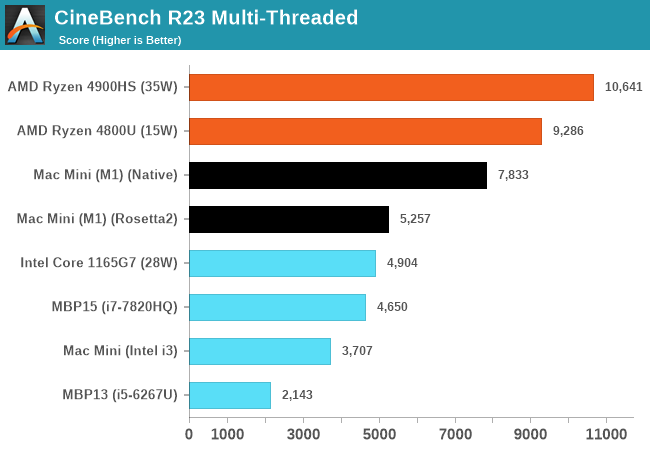
In the multi-threaded R23 runs, the M1 absolutely dominates past Macs with similar low-power CPUs. Just as of note, we’re trying to gather more data on other systems as we have access to them, and expand the graph in further updates of the article past publishing.
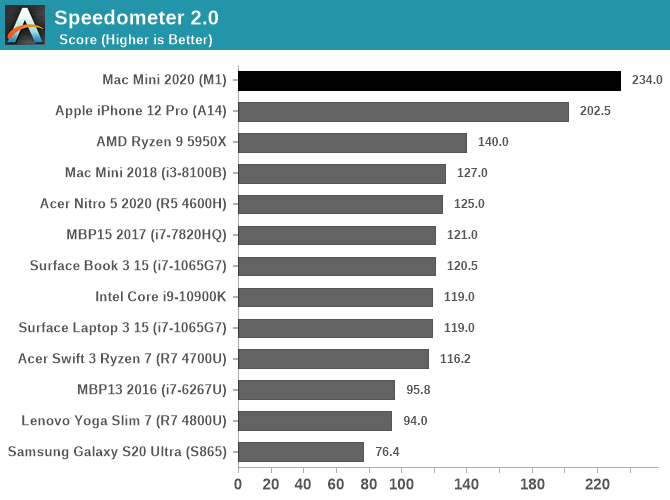
In browser-benchmarks we’ve known Apple’s CPUs to very much dominate across the landscape, but there were doubts as to whether this was due to the CPUs themselves in the iPhone or rather just the browsers and browser engines. Now running on macOS and desktop Safari, being able to compare data to other Intel Mac systems, we can come to the conclusion that the performance advantage is due to Apple’s CPU designs.
Web-browsing performance seems to be an extremely high priority for Apple’s CPU, and this makes sense as it’s the killer workload for mobile SoCs and the workload that one uses the most in everyday life.
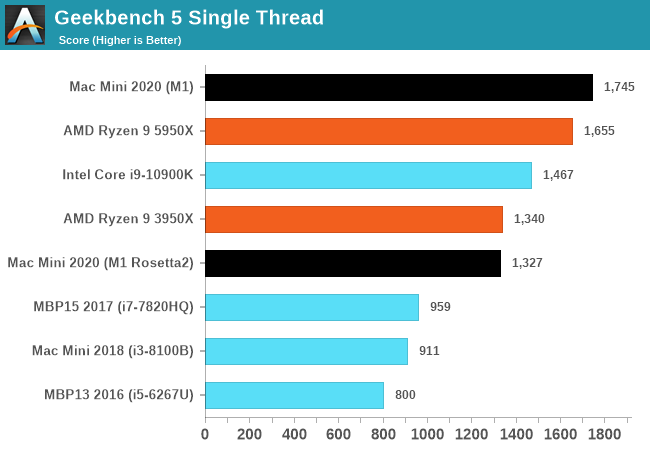
In Geekbench 5, the M1 does again extremely well as it actually takes the lead in our performance figures. Even when running in x86 compatibility mode, the M1 is able to match the top single-threaded performance of last generation’s high-end CPUs, and vastly exceed that of past iterations of the Mac mini and past Macbooks.
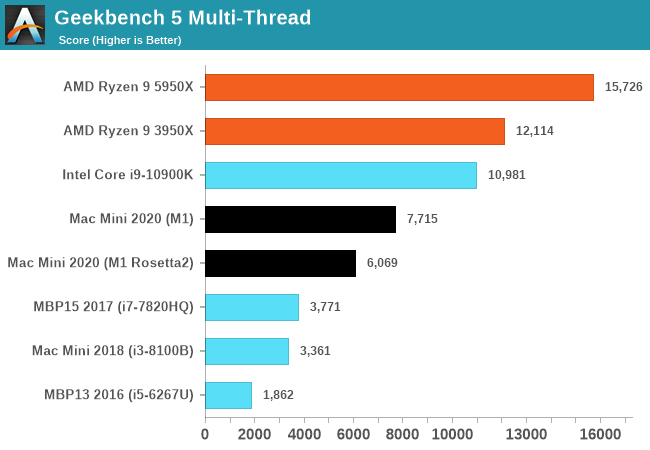
Multi-threaded performance is a matter of core-count and power efficiency of a design. The M1 here demolishes a 2017 15-inch Macbook Pro with an Intel i7-7820HQ with 4 cores and 8 threads, posting over double the score. We’ll be adding more data-points as we collect them.


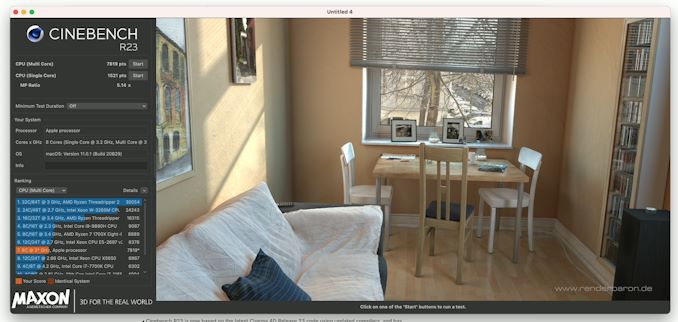








682 Comments
View All Comments
Rrrumble - Tuesday, January 25, 2022 - link
You may have missed the part where apple started the "business" (the smart phone, with the iPod as a first step) and grew and expanded it with savvy products and marketing while others tried catch up.Henry 3 Dogg - Friday, November 27, 2020 - link
"...Apple have tonnes of free cash that they could use to buy something they don't really need that makes money, but they don't do it. Instead they buy back their own stock. ..."Not true. Yes, Apple does buy back their own stock but they also have a subsidiary called Braeburn Capital which is sitting on around $250 Billion worth of investments.
theonetruestripes - Tuesday, December 1, 2020 - link
Apple _likes_ focus. When I worked there SJ made the point that Apple had incredible brand loyalty, but making some products that "make money" but are not as good as the rest of the products damages that brand loyalty. That seems pretty obvious to me at the time. Th other point he made is projects cost attention. If Apple launched a line of drink bottles it would take his time, designers time, marketing time, and many others. Some of that you can "just hire" if you have enough money, but you can't "just hire" more hours into the CEO's day, or SVP's days.To a certain extent that might not matter for something as distant from Apple's core business as say owning a CPU design firm. If Apple bought ARM and the ARM reference designs are "meh" very few people will decide that means the new MacBook Pro is "meh" by association. However it would still require some CEO time to decide "this new ARM subsidiary can't be called anything Apple related, and needs to make sure nobody is allowed to buy products from them and claim they are Apple related - we absolutely don't want a new "Apple Powered Dell" marketing campaign anywhere!"; how much money is that time worth? I'm sure there is some number at which you could say "if buying ARM makes this much per year it is worth 300 hours of Tim's time to close the deal and 16 hours per Q to make sure it doesn't screw anything up", but it may be a much higher number then ARM actually generates.
(or it might not, I expect a large part of Apple not being excited about buying ARM is lack of likelihood of getting regulatory approval, likelihood of needing to appear before congress to defend the purchase if in fact it is approved, and lack of any meaningful value to Apple (i.e. Apple has all the ARM license it needs to do anything it decides to))
alysdexia - Monday, December 28, 2020 - link
cares !-> they; 1 != 2; and you liardysonlu - Sunday, February 21, 2021 - link
If Apple buys Arm, not only does it have to keep licensing out Arm's designs but it may risk being forced to license its own CPU design/innovation as well since with Apple+Arm being a single entity, there is no longer any distinction in CPU intellectual properties between the two companies.Henry 3 Dogg - Friday, November 27, 2020 - link
Apple owned 43% of ARM for several years. There are more reasons than licensing technology to buy a all or part of a company.There are some very good reasons why Apple might choose to own 20% of ARM.
danbob999 - Tuesday, November 17, 2020 - link
Actually it's the opposite. It's the cheapeast/narrowest license from ARM. More expensive license include access to full Cortex cores, and not only instruction set.Spiderman10 - Tuesday, November 17, 2020 - link
No helios24 is correct. The Arch. license is at the top of the licensing pyramid. Anandtech actually wrote a piece about this here: https://www.anandtech.com/show/7112/the-arm-diarie...ws3 - Tuesday, November 17, 2020 - link
Danbob is confused by the fact that Apple doesn't use the ARM designs. He assumes that lack of use results from lack of access.RedGreenBlue - Tuesday, November 17, 2020 - link
They still based some designs closely to the generic ones. I think the A7 was shown to be only slightly modified in Anandtech’s review (the first 64-bit with Arm-v8(?))